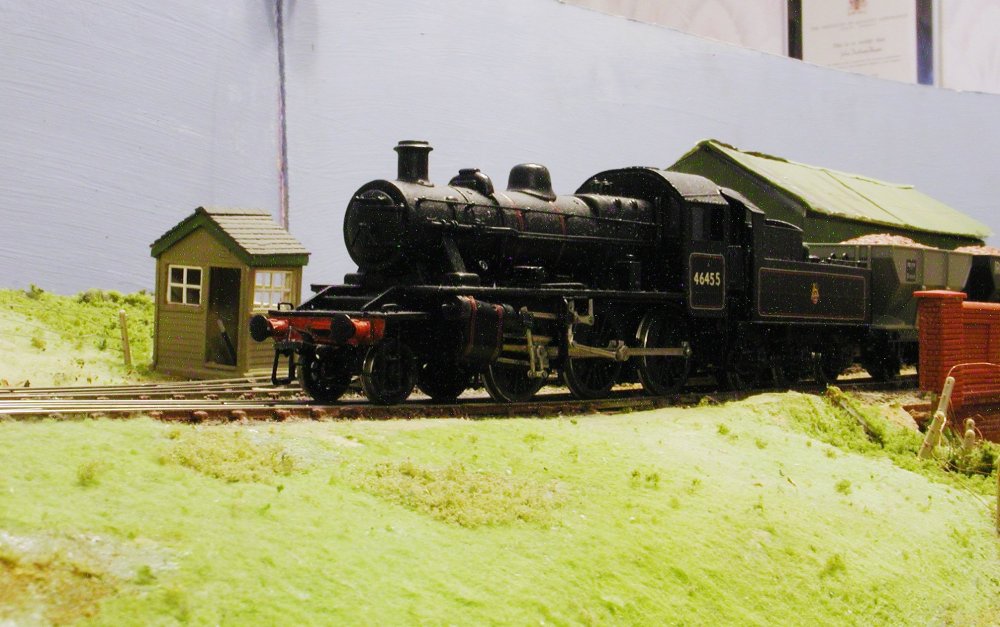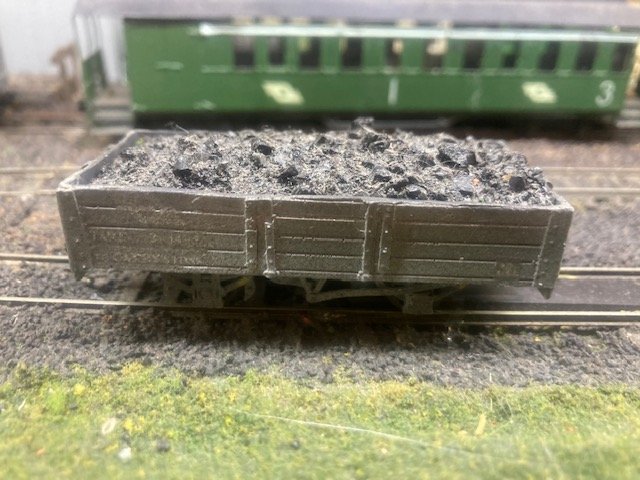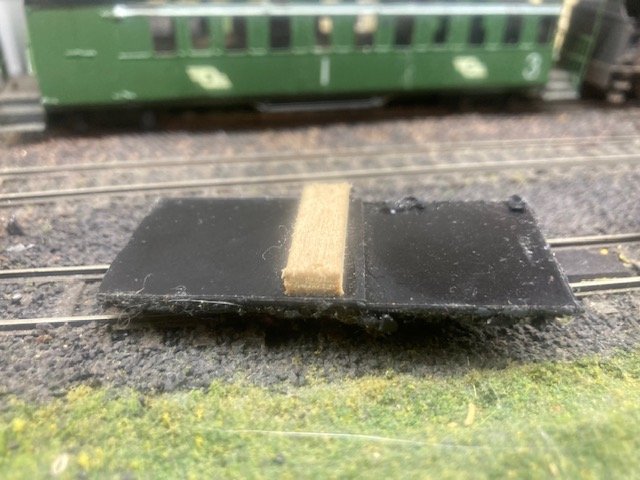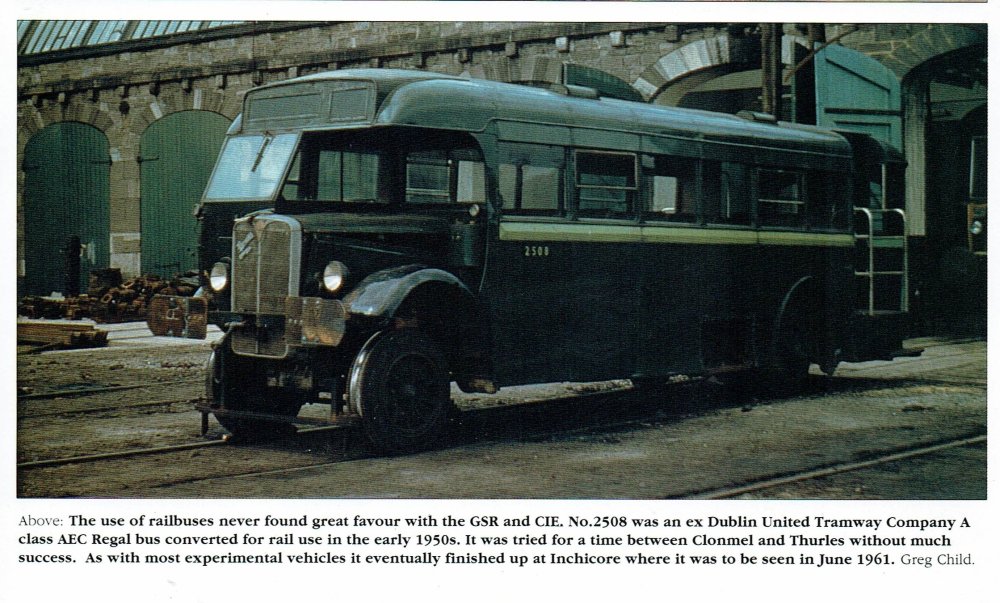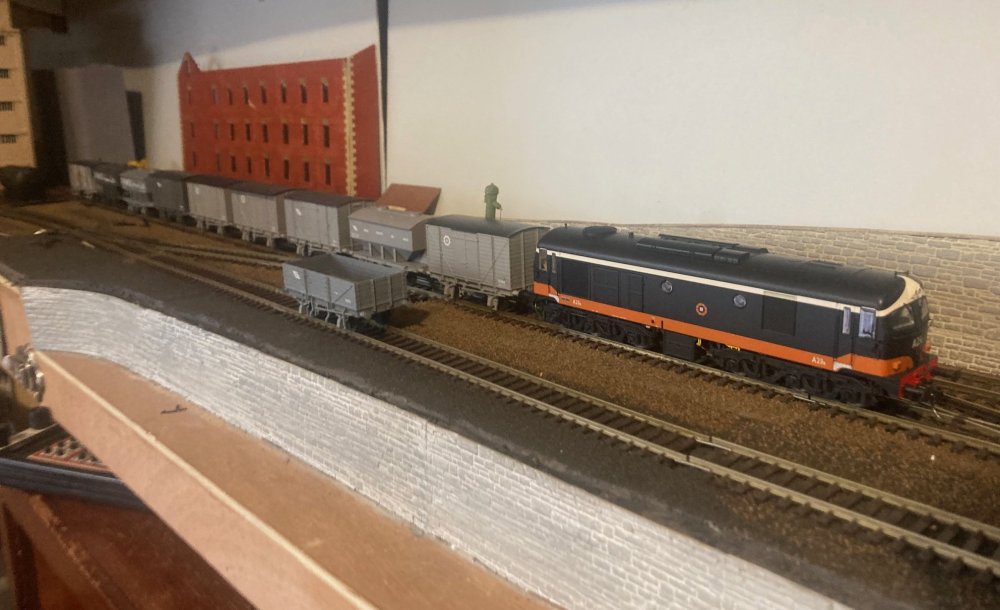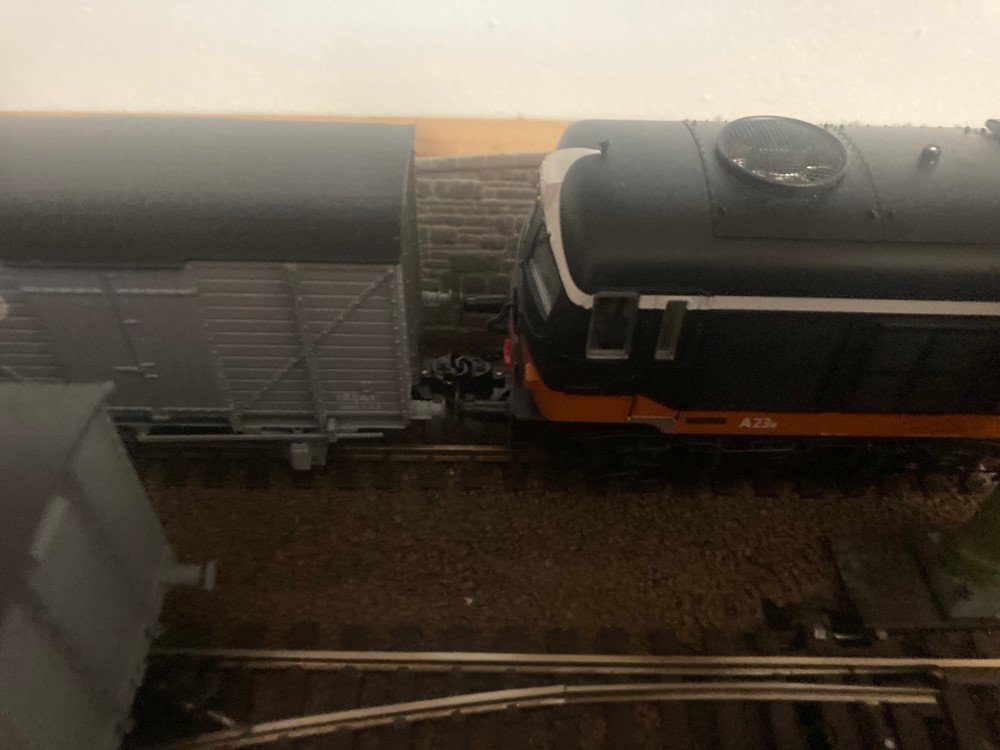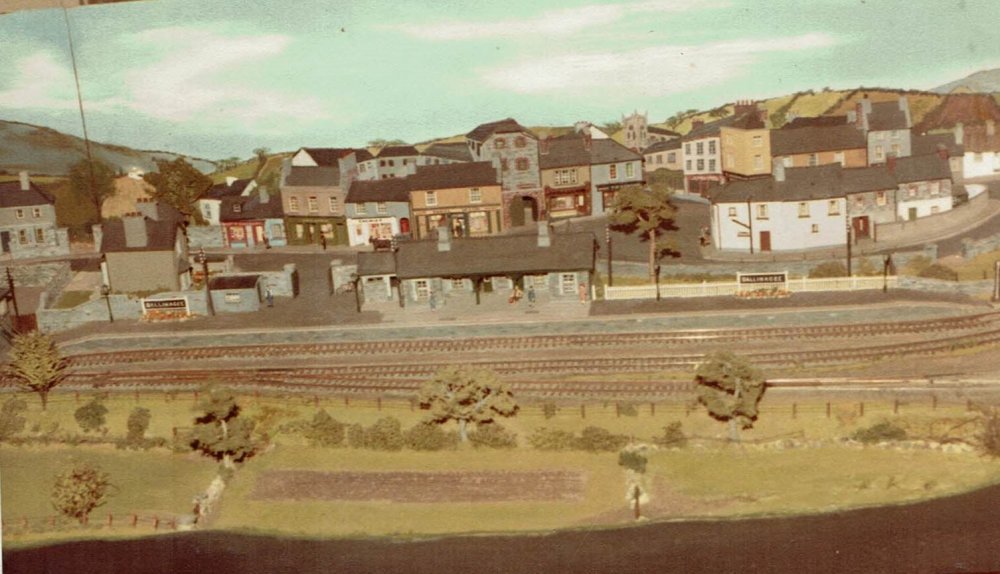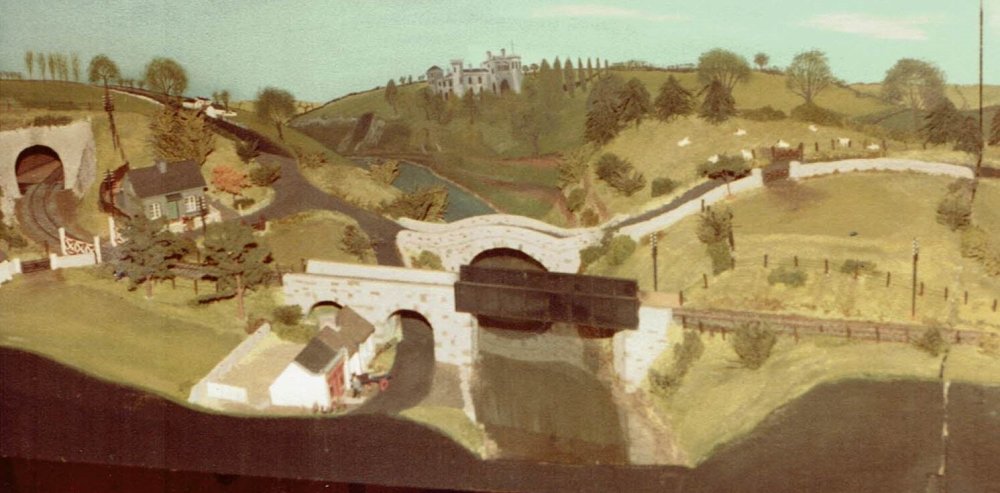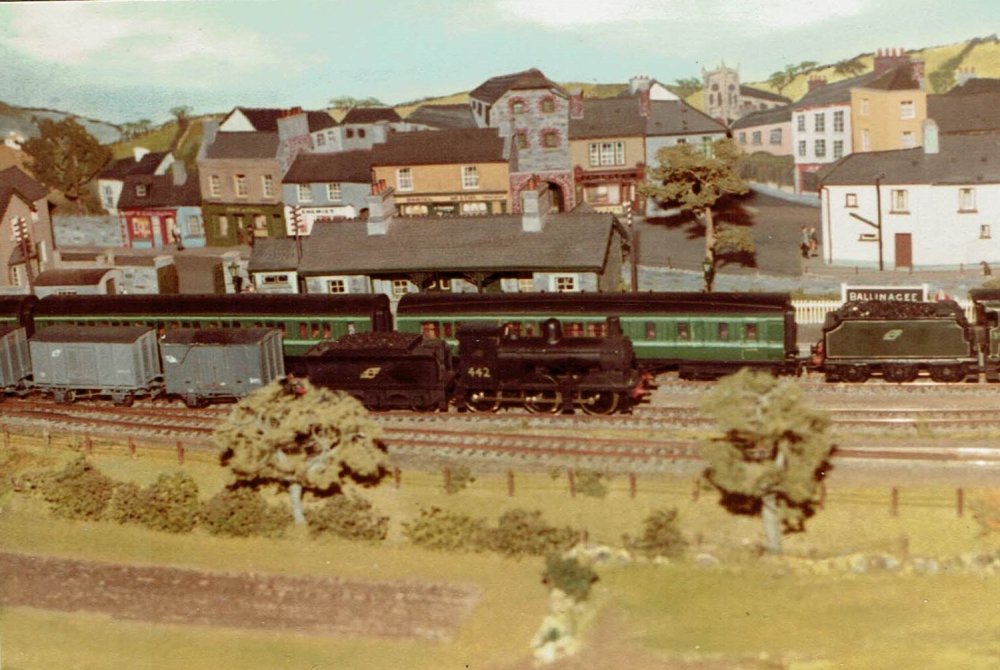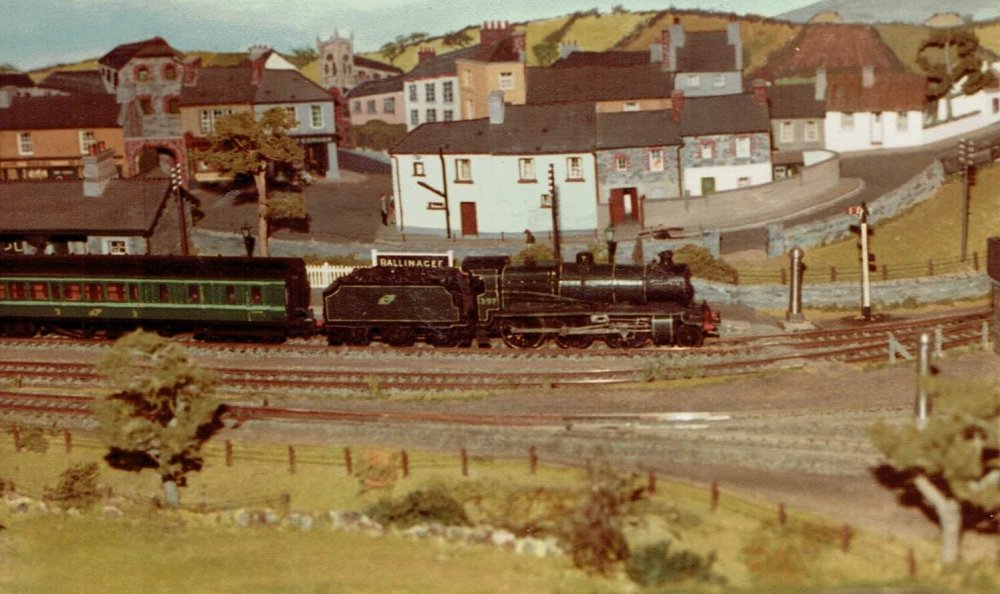-
Posts
4,875 -
Joined
-
Last visited
-
Days Won
119
Content Type
Profiles
Forums
Events
Gallery
Everything posted by Mayner
-

Limerick to Foynes railway reopening plan
Mayner replied to spudfan's topic in What's happening on the network?
Have IE/Shannon Foynes Port Company identified an actual freight flow/customer or allocated funding for terminal facilities when the line re-opens in 2025? -
Not much of interest in the way of shunting or the loading operation at Navan, the Dublin Port unloading operation is much more interesting with a lot more shunting. Basically the entire train of wagons is loaded inside a big shed, the only shunting as such is the loco running round the train. The entire Tara Mines operation was covered in an Irish Railfreight Video published by Paul Shannon during the early the 1990s, its possible Markle Associates may be able to help.
- 16 replies
-
- 3
-

-

-
- tara mines
- navan
-
(and 1 more)
Tagged with:
-
On the face of it Autumn makes sense relatively quiet time of year for cropping farmers and historically relatively dry settled weather conditions. The NZ Fieldays largest agricultural event in the Southern Hemisphere aimed mainly at the at the pastoral and forestry sectors held June (early winter) during the quiet period before the calving and lambing seasons when farmers have to work around the clock.. The Fieldays held in a permanent event centre is not as muddy as the ploughing https://www.fieldays.co.nz/attend-fieldays/about-fieldays
-
I built a small 4mm (EM gauge) industrial layout using C&L bull head track in a small apartment in the UK about 30 years ago! Pointwork handlaid using their abs chairs and sleepers and plain trackwork using C&L flexible track, fairly straightforward to use layout operated at home and at a number of exhibitions in Ireland and the UK including Warley As Horsetan indicated can work out expensive, especially if you use their pre-formed switch blades and crossing assemblies. Peco ready to lay Bullhead track system would probably be a better option if you are working in OO https://peco-uk.com/blogs/news/bullhead-oo-fine-scale-code-75-track Interestingly the chaired track is not too noticeable at normal viewing distance
-
Its being done in New Zealand one transport company is trailing a dual-fuel diesel-hydrogen truck for long haul work using the existing engine https://www.stuff.co.nz/national/131659022/southlandbased-transport-company-launches-dual-fuel-truck-powered-by-diesel-and-hydrogen-gas while hydrogen diesel conversions are being trialled on short haul waste disposal and civil engineering work in Auckland. Meanwhile Huyandi is pushing fuel cell technology with its Xcient range of trucks https://www.hyundai.co.nz/trucks/xcient/fuel-cell?gclid=EAIaIQobChMI9-qCsqywgQMV_R-DAx2MtAs8EAAYASAAEgJJKfD_BwE The fuel is carried in cassette/container mounted behind the cab on the diesel conversions, probably need a fuel tender (not unlike the Union Pacific Gas Turbines) for a diesel loco to run from the West of Ireland to Waterford and back. Don't think there is the traffic density to justify main line electrification in Ireland, though battery for passenger trains seems to be a no-brainer after all a Drumm Battery Train managed Amiens St-Gorey and back 90 years ago, before introducing battery trains into regular service on Dublin suburban duties.
-

Would you model in 21mm if RTR track and models were readily available?
Mayner replied to BosKonay's topic in Irish Models
Crude as hell I normally used flatbottom rail soldered to copperclad sleepers to represent flatbottom jointed track and bullheard rail with abs plastic chairs and sleepers for bullhead. I dropped a clanger of spacing the Yard tracks too close to the running line and struggled with getting double slip points to work! The main weakness was that I struggled to build a workable 21mm gauge layout within a 7'6" x1'6" space with 1:6 points, the same space is now occupied by a OO gauge Timesaver shunting layout which uses Peco small radius points and a run round loop and fiddle yard long enough for a Bo Bo diesel and 4-5 wagons. The MM B141 runs on Ultrascale EM profile wheels, stock mixture of modified OO wagon kits on Gibson wagon wheels on extended axles. If I was starting out again I would probably work to Double O Gauge Society Intermediate rather than EM standards, allowing stock IRM/MM/Bachmann wheels to be used, the increased OO running clearances potentially allow main line locos and stock to run through smaller radius curve/crossing angle than using EM or P4 standards -
Less is more in a way, the backscene with the coastline and hill really brings the layout to life.
-
My first proper job was as an Apprentice Barman for about four weeks in 1973 after I completed the Inter Cert before one of my teachers persuaded my parents to send me back to do the Leaving. After being shown how to pull a pint my first customer was a builder who paid for a pint with a Scottish £20 note that I thought was play money, the bar manager was pleased when I asked him about the note and the customer took it in good part and was happy with his pint. At the time bar trade was unionised at the time strictly male only and took family connections to get the job, I was technically minded wanting to go into engineering but ended up in construction management and regularly got to spend Scottish banknotes 20 years later! Think Dublin Dairies and TEK used horse drawn milk floats into the 60s. Some smaller Dublin Market traders and coal men used horses into the 70s-80s, there are tales of travelers and traders taking their horses in the lifts of Ballymun Flats, before the 'urban youth horse" culture developed into a major phenomon on the 'praries" on the Council Estates on the outskirts of Dublin City during the late 80s and 90s.
-
Depends on whether you consider the CIE 121 Class a variant of the General Motors GL 8 and GA 8 export model or vice versa because some variants share a common cab design. The B121s are considered to he a high cab variant of the GL8 model of which 96 Bo-Bos appear to have been supplied in total including 69 to Brazil (metre gauge), 15 Ireland, 12 Tunisia, 53 A1A A1A 12 Taiwan & 41 Bangladesh, 12 Co Co Queensland Australia (3'6' The 96 (5'3") Victorian Railways (Australia) T Class (Variant EMDG8 built under licensein Austraia) are considered to have been the inspiration for the GL8 and B121 Class The 94 GA 8 export locos ran on wagon trucks (bogies) with two traction motors mounted in the loco body used mainly in Central and South America. Not to be outdone Australia produced a 600hp 3'6" gauge Bo Bo loco which looked similar to the B121 Class Rtr models and kits may be available of the Victorian T and various GL & GA 8 variants in HO Scale, one of the big surprises was that Australian modellers and manufacturers like their American counterparts model the standard gauge in HO scale.
-

Clogherhead - A GNR(I) Seaside Terminus
Mayner replied to Patrick Davey's topic in Irish Model Layouts
Interesting . I use removable wagon loads, in this case coal glued with PVA to thick plasticard and a stripwood packing piece. Wagon body was cast in resin part of a rake of 8, 10 years dust and pet dander has taken the sheen off the coal! -

Ernies Massive Irish 1930's to 2005 Photo Archive
Mayner replied to Glenderg's topic in Photos & Videos of the Prototype
Its likely that some of the criticism of ex-Midland locos in the GSR/CIE as sluggish and poor steamers may have been due to the lack of familarity with Midland locos on the Southern and at Inchacore. With a few exceptions ex-MGWR 2-4-0s on DSER and Bray Suburban trains, a pair of 0-6-0s a Standard Goods and a Cattle engine on loan to Waterford for the Beet Season and the successful use of ex-MGWR Cs Class 4-4-0s on Kingsbridge-Nenagh-Limerick trains during the 1930s, ex-MGWR locos worked the majority of goods and passenger trains on the Midland until displaced by railcars and diesels. Jack O'Neil describes his first 1946 run as a fireman on 540 assisting the down Galway Mail from Mullingar to Athlone, talks about the rough riding (Woolwich Moguls also had a bad reputation) advised if he had false teeth to take them out when getting on! Described the loco as free steaming and easy to fire and a steady runner until "notched up beyond 65%" (worked hard) Jack's last fired one of the Class "being worked to death" on DSER suburban service "until no longer safe to be on the road" in 1954 . Also notes a high speed (70max) 1954 run with 543 on the "Caddagh" (Dublin-Galway via Portarlington) a precursor of the Cu na Mara" railcar express of the 50s and 60s and a 1939 run on a Limerick-Kingsbridge via Nenagh with 60mph running. The MGWR large 4-4-0s appear to have been designed as mixed traffic locos capable of hauling heavy passenger and livestock trains, the locos had smaller 6'3" driving wheels and the valve gear was set up differently to the GSWR 6'7" 4-4-0s which were designed for high speed running on the Cork Main line. The MGWR 4-4-0s would have had to be worked harder to achieve a similar speed which would have also increased maintenance costs. It likely that overloading and a backlog of maintenance became a significant problem during the CIE era as train frequencies were reduced in an attempt to control CIEs worsening financial position and overloading was identified as a significant problem with the Woolwich Moguls and rebuilding of some Moguls as 4-6-0s Woolwich cylinders and motion, 400 Class boilers was actually proposed -

Ernies Massive Irish 1930's to 2005 Photo Archive
Mayner replied to Glenderg's topic in Photos & Videos of the Prototype
Interesting photo of 543 formerly MGWR C Class No10 "Faugh-a-Ballagh" at Wexford in 1954. The Class had a reputation of rough riding being considered top heavy and poorly sprung, its possible the bogie is out for attention to a bearing. -
CIE converted an ex-GNR DUTC AEC Regal bus into a railbus during Howden's brief period as CIE General Manager before becoming UTA Chairman. CIE seems to have lost interest after Howdens departure, like the UTA no need for railbuses or branch line railways when it could operate its own bus and road freight services. Oddly Thurles-Clonmel was one of the few bus routes licensed to a private operator after the railway closed, CIE found the Thurles-Clonmel route unprofitable and licensed the service to a private operator. Don't know if anything is available with a similar roof profile destination board arrangement.
-
Haven't had time to do anything on the model railway front since the beginning of June, though I recently managed to dust North Wharf off for a short operating session using A23r as motive power rather than the usual B121 which revealed a problem with buffer locking with the larger loco and wagons running through Peco Small Radius points. The backstorey was that Northwharf remained open for goods traffic after regular services ceased in the early 70s, an Ar supplied to work a special of imported animal feedstuff" and shunt the yard after a ship was diverted to Northwharf as a result of a storm. Looking the part train made up and ready to depart behind A23r. A considerable amount of shunting was involved in making up the train as only 3 wagons at a time could be loaded at the "Mill" Buffer locking developing as A23r begins to propel a cut of wagons over the crossover between the main running line and loop (Kadee 19 Coupler) Buffers now locked with wagons propelled through crossover onto loop, de-railment likely if loco continues to propel wagons. Loco and wagons buffers and couplings in normal position. Loco was uncoupled from the wagons during the shunt and the wagon moved with a pinch bar. Lesson ban 6 axle diesels from North Wharf! The model Metrovicks tended to be a bit clumsy for shunting and more importantly took up more space on the traverser than the Bo Bos reducing the train length for 4-3 wagons. The main reason for using the small radius points was to fit the "Timesaver" track layout into the available space! Curiously Jack Kennedy spoke about the SLNCR 0-6-4Ts regularly bufferlocking when shunting the yards, giving the photographers plenty of time to compose/set up their photos!
-
Great to hear that John Walker is still producing fine work after all those years, first came across John's work with his Ballinagee Layout over 40 years ago, the the time there was virtually no commercial support for Irish modelling, buildings, structurers, locos and stock were mainly scratchbuilt or heavily modified rtr. The main exceptions would have been the Woolwich (Wills whitemetal kit) and re-painted Palitoy LMS corridor coaches, the steam locos which included ex-DSER 0-6-0 442 and ex-WLWR 2-4-0 290 (Enniscorthy Pilot Loco) were built in plasticard with Arfix tender drive and scratchbuilt non-powered loco chassis
- 16 replies
-
- 10
-

-

-

Clogherhead - A GNR(I) Seaside Terminus
Mayner replied to Patrick Davey's topic in Irish Model Layouts
The pavilion on the slightly foamboard has a nice windswept East Coast atmosphere of where the Central Plain meets the Irish Sea in Meath and Louth with the station 'in the middle of "no where" between the village and the sea/quay with the plain falling off steeply to the sea. I'd think a less is more approach might be the most effective with just railway buildings, big sky backscene possibly church spire and roofs of buildings in village in background, there is not a lot to be seen along the coast from Rush to Drogheda and Gormonstown Station was a pretty good study in rural seaside isolation. Yaal have to work on the Louth dialect for the railway people and locals, spent a day working with railway people from the area thought they were speaking a foreign language maybe French. -
One of the more interesting provisions of the Great Northern takeover agreement was that the Republic could subsidise loss making rail services in Northern Ireland if Stormont declined and vice versa. Merrion Street was equally inward looking declining to subsidise the "Border Lines' in Northern Ireland when it had the opportunity, which would have been a major good will gesture towards Northern Ireland and support for the Border Region (on both sides of the border) at relatively little cost. Ironically the Northern Ireland minister of transport who presided over the 1950s closures was from the economically liberal wing of unionism which favoured improved community relations within Northern Ireland and improved relations with the Republic. The Northern Ireland Government was opposed to subsidising the railways as they believed correctly that the could not be made to operate at a profit, while UTA road services could be made to "pay its way" The UTA was not slow about opening up cross border bus and intercity coach routes or carrying cross border road freight traffic.
-

Glasgow & South Western Railway Class 403 2-6-0
Mayner replied to David Holman's question in Questions & Answers
Saw Hattons and automatically assumed it was rtr, though I bought a few Gem locos kits from Hattons "back in the day" Actual no's of locos built of popularity of a particular loco often seems to have little to do with a manufacturers/commissioners choice of a particular model the Triang "Nellie" was apparently inspired by the LSWR C14 not exactly a large or well known class and the recent Hornby Hush-Hush a "one off" With the intense competition in the British model railway market whether Hornby Hobbies under its current owners focuses its energies away from model railways towards the high turnover toy end of the the market. -
Similar to the LGB G Gauge American Forney loco, curiously the GSWR built at least on of its 0-4-4BT locos as a Fairlie (double bogie) but appears to have been withdrawn/re-built before the "Amalgamation"
-
The majority of our wagons are available in undecorated form on pre-order. I am currently unable to supply rtr decorated wagons or undertake loco/stock building commissions as a result of family commitments. https://jmdesignmodelrailways.com/
-
- 5
-

-

Glasgow & South Western Railway Class 403 2-6-0
Mayner replied to David Holman's question in Questions & Answers
It looks like Hattons a planning to introduce a OO Gauge rtr Caledonian 2-6-0 Went through a phase of assembling kits of 'modern" British outline steam locos about 20 odd years ago only for Hornby or Bachmann to release a rtr model 6-12 months later. Never thought anyone would introduce a model of a Scottish 2-6-0 https://www.hattons.co.uk/directory/vehicledetails?id=3144935 -

Glasgow & South Western Railway Class 403 2-6-0
Mayner replied to David Holman's question in Questions & Answers
As they say a picture or a couple of pictures are worth a thousand words. DSER 2-6-0 originally planned as a large boilered 0-6-0, boiler diameter reduced and pony truck fitted. GSWR 2-6-0 358 originally built 1903 as an 0-6-0 re-built 1907 as a 2-6-0 later re-built with GSR cab and large belpair boiler. A rather Scottish looking locomotive? K3 357 originally built 1903 as an 0-6-0 rebuilt with Belpair boiler and GSR cab K4 359 built as a 2-6-0 1909 rebuilt with Belpair boiler and Inchacore cab 1935 Chief spotting difference between the K3 and K4 seems to have been the framing at the front end and cab roof profile -
The cattle wagon looks relatively modern by the standards of the time a 14' Van similar in appearance to the GNR(I) vans built into the 1950s, a wooden top rail rather than a metal rail at door head level and solid planked sides appear to be the main spotting diffrences.
-
The Brake Vans two different designs on with/one without veranda appear similar in construction and outline to a MGWR design dating from the 187O. Martin Atock held the post of Waterford and Limerick Locomotive Superintendent for 11 years before moving to the Midland in 1872 and may have designed the Brake Vans in the photos. The 'Covered Wagon" beside the crane in the second photo appears to be a MGWR design, the other covered wagons appear to be GSWR with their distinctive end framing with a single post supporting the roof. I think most of the wagons on Richard Chown's Castle Rackrent layout were based on British Rolling Stock Manufacturers drawings from UK museum collections.
-
There is a July 39 photo of Kilmeadan looking West in "Lost Railways of Co Dublin and the South East. The striped post in the background is part of the system for exchanging the electric train staff at speed. The striped post is fitted with a hoop apparently for picking up the staff from trains arriving at speed, staffs appear to have been picked up from a mechanism mounted on a shorter post. It looks like the GSR operated "up and down" running through crossing loops on the "Boat Train Route" at this stage with both roads of equal importance, this was unlike the Dublin-Galway line and the NCC North of Ballymena where one road through single line crossing places was aligned for high speed non-stop running and designated the main line, the other road designated the loop. Its possible the small platform was provided for manually exchanging staffs on trains held in the loop with the loco stopped past the end of the platform, starting signal for Waterford West? likely to be on the Waterford side of the bridge. Current signals likely to be cosmetic to provide atmosphere, signal cabin, crossing loop and sidings likely to have been removed following the closure of the Waterford-Mallow Line, staff sections became ETS Waterford West-Kilmacthomas, one engine in steam/train on line Kilmacthomas-Ballinacourtney
.png.c363cdf5c3fb7955cd92a55eb6dbbae0.png)

